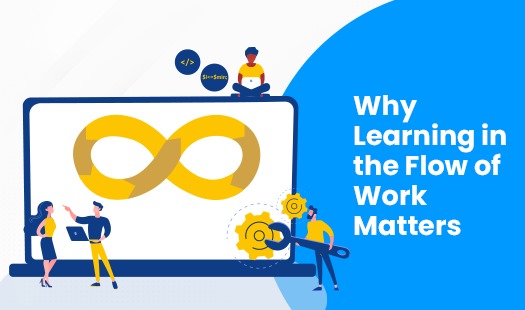
The modern workplace highly values agility and adaptation, and learning while working has evolved as a revolutionary method for organizational growth and success. This massive shift in learning methods extends beyond the conventional boundaries of formal, classroom training sessions, allowing employees to easily access information and abilities as they handle their everyday duties and problems. But why is learning in the flow of work so important in today’s context? Read on to find out.
1. Address Agility in a Dynamic Environment:
In today’s quickly changing business world, firms must provide their workers the freedom to adapt and prosper amidst continual change. Workplace learning promotes adaptation by providing employees with appropriate information and skills when needed. Microsoft, for example, has created “Microsoft Learn,” an integrated learning platform built into productivity tools such as Microsoft Teams and SharePoint. This enables employees to effortlessly access learning resources while completing their everyday responsibilities, enabling ongoing skill development in line with business goals.
2. Enhance Engagement and Relevance:
Traditional learning techniques frequently need greater engagement and relevance since employees require assistance seeing the immediate use of newly acquired knowledge. Organizations may provide individualized and contextualized learning experiences relevant to employees’ current needs and issues by incorporating learning into the flow of work. For instance, Salesforce utilizes its “Trailhead” platform to offer short learning sessions directly connected to its CRM software. This enables salespeople to acquire instant product knowledge and sales skills, leading to higher engagement and productivity.
3. Encourage Continuous Learning and Collaboration:
Workplace learning fosters an atmosphere where people constantly learn and collaborate by incorporating information exchange and skill development into everyday tasks. Platforms like Slack incorporate learning bots and channels, enabling employees to discuss, share best practices, and seek advice from experts without disrupting their work. This collaborative learning strategy draws on the team’s pooled experiences and knowledge.
4. Align Learning Initiatives with Strategic Business Objectives:
Implementing a strategic approach to workplace learning and integrating learning activities with the organization’s business goals is critical. IBM’s “Your Learning” platform uses AI and data analytics to give personalized learning suggestions based on workers’ jobs and career goals. This ensures that employees have the necessary skills to deliver effective company outcomes.
5. Leverage Data and Analytics for Continuous Improvement:
Workplace learning enables businesses to analyse outcomes, evaluate effects, and constantly improve procedures. Walmart employs advanced analytics to examine learning data from their “Walmart Academy” platform, discovering trends and patterns that enhance training program success. This data-driven technique enables real-time modifications, providing the best return on learning efforts.
Learning in the flow of work is a change in corporate training that enables employees to learn and build abilities while performing their usual duties. This strategy may boost flexibility, engagement, cooperation, alignment with strategic goals, and continuous improvement through data analysis. Adopting this strategy is critical for firms to reach their full potential and remain competitive in today’s business conditions.

